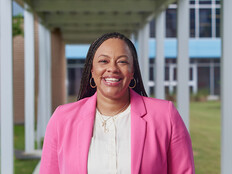Continuing Advocacy Programs and Forging New Partnerships Are Keys to Creating Digital Equity
It’s not news that schools have gone digital. Learning is touted as “anywhere, anytime.” About 50 percent of teachers report having a one-to-one computing program. But what happens if a student doesn’t have internet access at home to do the same work other students are doing?
This is the reality for about five million households, Pew Research Center reports.
This digital divide and homework gap are what administrators, teachers and even some major corporations are clamoring to solve.
Google Fiber has plans to transcend the physical barriers that exist for some communities and test cheap, wireless, high speed internet in 24 metropolitan areas nationwide, The Christian Science Monitor reports.
Sprint’s 1Million Project plans to connect 200,000 high school students each year for five years by giving away mobile devices with limited LTE data service, eSchool News reports. The project will begin in seven to 10 cities, with a full rollout nationally set to start in September.
“Education is the foundation for our society to prosper, and the internet is an incredibly powerful tool for learning,” says Sprint CEO Marcelo Claure in the article. “But it’s a huge problem in America that we have 5 million households with children that lack internet connections. Those kids have a huge disadvantage and we are failing them.”
While programs like these bring awareness to the digital equity issues across the country, CoSN CEO Keith Krueger says it will take more than corporate programs to solve the problem.
“It signals that even these companies recognized that education has gone digital and we’re disadvantaging those students that can’t connect digitally at home,” says Krueger. “We see that as one piece of the puzzle, not the whole puzzle.”
For Krueger, the partnerships that school districts can forge with local government and businesses in the community are the biggest component of creating digital equity.
School Districts Work with Communities to Connect Students
Districts like Forsyth County Schools in Georgia have noticed certain “Wi-Fi deserts” in their community, and have stepped up efforts to show students where they can find nearby access, details CoSN’s digital equity report for 2016.
Through a partnership with the local chamber of commerce, the district created a free Wi-Fi directory that lists access locations where students can get online to do their schoolwork. Participating businesses get a sticker to indicate they are a “Free Wi-Fi Zone.”
“Creating a Free Wi-Fi Directory is a natural expansion of services that support our community’s high quality of life standard,” says James McCoy, president and CEO of the Cummings-Forsyth County Chamber of Commerce, in the report.
“By working together to identity and map free Wi-Fi locations, we will create a cloud of coverage that not only benefits students, but those that also live and work in the community.”
Krueger indicates Wi-Fi mapping as a low-cost solution for cash-strapped districts, but relying on public access is not always perfect.
“I think there are two buckets in bridging the homework gap: outside community access and the home problem,” says Krueger. “I think the home problem is the most difficult to solve.”
But some school districts have been working hard to get internet into the homes of their students who lack it.
When Kansas City Public Schools found out that 70 percent of their students didn’t have internet access at home, they partnered with the public library and local nonprofit organizations to pilot a mobile hotspot lending program that began in 2015, The Kansas City Star reports.
A similar program at New York City public libraries in Manhattan and the Bronx began in 2014, then expanded to the Brooklyn Public Library in 2015. THE Journal reports that the library is now allowing families to “check out” a data-capped hotspot for the entirety of the school year.
What a New Administration Means for Federal Digital Equity Programs
Schools are making strides to bridge the homework gap, but Krueger thinks it will be very difficult to solve the problem without the help of federally subsidized programs.
Changes to the FCC’s Lifeline program — which gave low-income families a stipend for landline and mobile voice services — enacted by former chairman Tom Wheeler allowed for eligible families to use their federal credit for broadband internet, The Washington Post reports.
But earlier this month, new FCC chairman Ajit Pai told nine new service providers that they wouldn’t be able to participate in the Lifeline program, in a sense reversing Wheeler’s initial decision to give those companies the go-ahead for providing discounted internet via the federal credit.
Though a small blow, Krueger says CoSN is troubled by the precedent this might be setting.
“CoSN stands firm in our steadfast commitment to better connect all learners at home and in school. Our nation’s leaders need to take steps to close, not increase, the digital divide in communities nationwide,” says the organization’s official statement.









